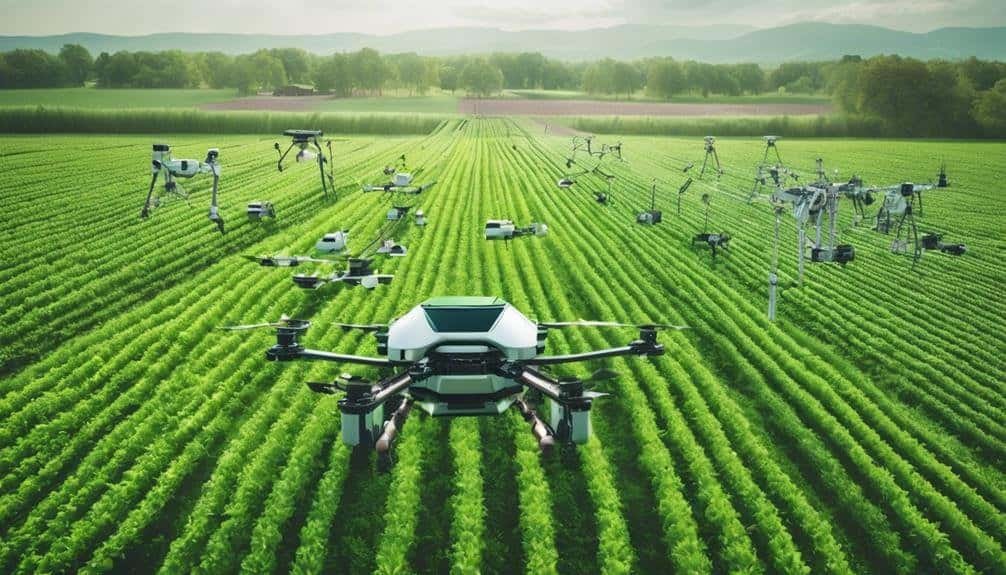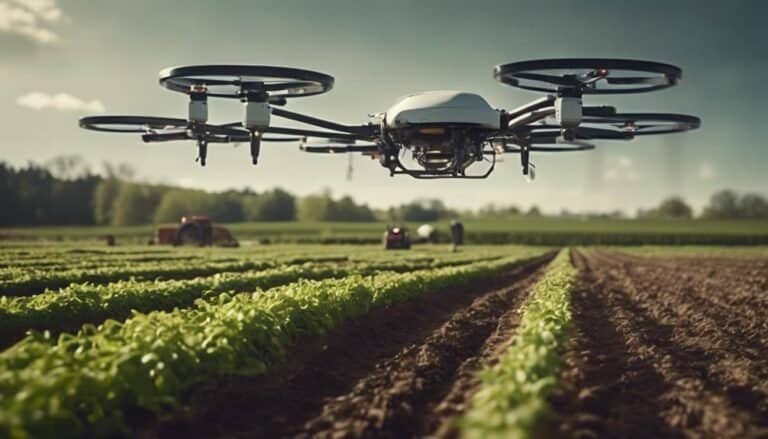AI in Agriculture: The Complete Guide
In the modern era, where technology continues to revolutionize various industries, the agricultural sector has also witnessed a significant transformation through the integration of Artificial Intelligence.
Imagine a world where crops are nurtured with precision, resources are optimized, and sustainability is prioritized. As you explore the intricate ways AI is shaping the future of agriculture, you will uncover not just the current applications but also the untapped potential and challenges that lie ahead.
Discover how AI is not just a tool but a game-changer in revolutionizing the way we cultivate our food.
Key Takeaways
- AI revolutionizes farming with data analysis and automation for enhanced productivity and sustainability.
- Precision agriculture techniques enable detailed monitoring and resource optimization for efficient farming practices.
- Machine learning empowers farmers with accurate predictions and recommendations for improved crop yield.
- Predictive analytics and technology innovations in agriculture reduce risks and enhance productivity for sustainable farming.
AI Applications in Farming
AI technology is revolutionizing farming practices by optimizing crop yields and resource allocation through data analysis and automation. One key application of AI in farming is yield prediction. By analyzing historical data, weather patterns, soil conditions, and crop health metrics, AI algorithms can accurately predict crop yields. This enables farmers to make informed decisions regarding planting, harvesting, and resource allocation, ultimately maximizing their productivity and profitability.
Another crucial application of AI in agriculture is pest control. Through the use of sensors, drones, and satellite imagery, AI can detect early signs of pest infestations or diseases in crops. By analyzing vast amounts of data in real-time, AI can pinpoint areas affected by pests and recommend targeted solutions, such as precision spraying of pesticides or implementing biological pest control methods. This proactive approach not only minimizes crop damage but also reduces the need for excessive pesticide use, promoting sustainable farming practices.
Benefits for Crop Management
Efficient crop management practices leverage advanced technology to optimize resource allocation and improve overall agricultural productivity. When it comes to benefits for crop management, AI plays a crucial role in enhancing weather forecasting and irrigation scheduling.
Weather forecasting is a critical aspect of crop management as it helps farmers make informed decisions about planting, harvesting, and disease control. AI algorithms analyze vast amounts of data from satellites, weather stations, and sensors to provide accurate weather predictions. By utilizing AI for weather forecasting, farmers can mitigate risks associated with extreme weather events, optimize planting times, and improve overall crop yield.
Irrigation scheduling is another area where AI brings significant benefits to crop management. AI-powered systems monitor soil moisture levels, weather conditions, and crop water requirements to create personalized irrigation schedules. By providing the right amount of water at the right time, AI helps farmers conserve water, reduce costs, and enhance crop quality. Additionally, AI can detect leaks in irrigation systems, prevent water wastage, and ensure efficient water usage on farms.
Precision Agriculture Techniques
Utilizing cutting-edge sensors and data analytics, precision agriculture techniques revolutionize farming practices by optimizing resource utilization and enhancing crop yield potential. These techniques leverage advanced technologies to provide farmers with detailed insights and actionable data for more efficient and sustainable agricultural operations.
- Crop Mapping Techniques: Through the use of drones, satellites, and ground-based sensors, farmers can create detailed maps of their fields, enabling them to monitor crop health, identify areas of concern, and make informed decisions on irrigation and fertilization.
- Sensor Fusion: By combining data from multiple sensors such as GPS, moisture sensors, and spectral imaging devices, farmers can gain a comprehensive understanding of their fields in real-time. This fusion of data allows for precise decision-making and targeted interventions.
- Variable Rate Applications: Using algorithms and data analysis, farmers can implement variable rate applications of inputs such as water, fertilizers, and pesticides. This tailored approach ensures that resources are applied where they're needed most, maximizing efficiency and reducing waste.
- Remote Sensing: Remote sensing technologies enable farmers to monitor their fields without the need for physical presence. By collecting data on crop health, soil conditions, and weather patterns from a distance, farmers can make timely adjustments and optimize their farming practices for better outcomes.
Role of Machine Learning
You can leverage Machine Learning techniques to enhance crop yield predictions and optimize agricultural practices. Predictive analytics applications powered by ML algorithms can provide valuable insights into crop health, disease detection, and yield forecasting.
ML for Crop Yield
Machine learning techniques play a crucial role in predicting and optimizing crop yield in modern agricultural practices.
- Yield Prediction: Machine learning algorithms analyze historical and real-time data to forecast crop yields accurately.
- Crop Modeling: By utilizing machine learning models, farmers can simulate various scenarios to understand how different factors impact crop growth and yield.
- Precision Agriculture: ML algorithms enable farmers to apply resources such as water, fertilizers, and pesticides with precision, leading to increased crop yields and cost savings.
- Decision Support Systems: Machine learning systems provide farmers with data-driven insights and recommendations, aiding in making informed decisions to optimize crop yield.
These applications of machine learning empower farmers to make data-driven decisions that enhance productivity and sustainability in agriculture.
Predictive Analytics Applications
Predictive analytics applications in agriculture leverage advanced machine learning techniques to forecast and optimize crop yields with precision and efficiency. By analyzing historical data and real-time information, machine learning models can predict future outcomes, enabling farmers to make informed decisions.
Weather prediction plays a crucial role in these applications, allowing for proactive measures to be taken in response to upcoming weather conditions. Machine learning algorithms can also assist in pest control by identifying patterns and early signs of infestations, helping farmers implement targeted interventions.
Through the integration of predictive analytics in agriculture, farmers can enhance productivity, reduce risks, and ultimately improve the sustainability of their operations.
Improving Yield and Efficiency
Utilizing advanced AI algorithms and precision agriculture techniques can significantly enhance crop yield and operational efficiency in modern farming practices. These technologies play a vital role in improving yield prediction and efficiency enhancement.
Here are four key ways AI is revolutionizing agriculture:
- Predictive Analytics for Yield Optimization: AI algorithms analyze various data points such as weather patterns, soil quality, and historical crop performance to predict potential yields accurately. This enables farmers to make informed decisions regarding planting strategies, crop selection, and resource allocation, ultimately maximizing productivity.
- Precision Farming Techniques: AI-powered precision agriculture tools help farmers optimize inputs like water, fertilizers, and pesticides by providing real-time data on crop health and soil conditions. By precisely tailoring these inputs to the specific needs of each area within a field, farmers can reduce waste and improve overall efficiency.
- Automated Monitoring Systems: AI-driven monitoring systems use sensors and drones to collect data on crop growth, pest infestations, and irrigation needs. By continuously monitoring these factors, farmers can detect issues early, take preventive measures, and ensure optimal conditions for crop growth, leading to increased yields.
- Smart Machinery Integration: AI-enabled machinery can perform tasks such as planting, spraying, and harvesting with high precision and efficiency. These machines can autonomously adjust their operations based on real-time data, reducing human error and saving time, thus enhancing overall operational efficiency on the farm.
Data-Driven Decision Making
You can leverage precision farming benefits by utilizing AI to analyze vast amounts of data for informed decision-making. Yield optimization strategies can be enhanced through AI algorithms that identify patterns and trends in crop growth and environmental conditions.
Additionally, AI enables real-time crop health monitoring, allowing for proactive measures to maintain optimal plant conditions and improve overall yield.
Precision Farming Benefits
By harnessing the power of data analytics, precision farming enables you to make informed decisions that optimize crop yields and resource utilization. Here are four key benefits of precision farming:
- Precision Irrigation Techniques: Utilize data to tailor water distribution to crops' specific needs, reducing water wastage.
- Soil Nutrient Management: Analyze soil data to determine precise fertilizer requirements, enhancing nutrient uptake and minimizing environmental impact.
- Crop Yield Forecasting: Predict future yields based on historical data and current conditions, aiding in better planning and market strategies.
- Weather Data Analysis: Incorporate real-time weather data to adjust farming practices accordingly, mitigating risks and maximizing productivity.
With precision farming, you can leverage data to optimize every aspect of your agricultural operations for improved efficiency and sustainability.
Yield Optimization Strategies
Optimizing crop yield through data-driven decision-making involves analyzing key factors to enhance productivity and efficiency in agricultural operations.
Crop modeling techniques play a crucial role in yield prediction by utilizing historical data, soil characteristics, and crop-specific parameters to forecast potential yields.
Integrating weather data into these models allows for real-time adjustments, enabling farmers to make informed decisions on irrigation, planting schedules, and crop protection measures.
By leveraging this data, farmers can optimize their yields by adjusting inputs such as water, fertilizers, and pesticides precisely where and when needed.
This data-driven approach not only maximizes crop production but also minimizes resource wastage, ultimately leading to improved profitability and sustainability in agriculture.
Crop Health Monitoring
Analyzing crop health through data-driven decision-making involves monitoring key indicators to optimize agricultural practices and ensure optimal yields. When it comes to crop health monitoring, here are four crucial aspects to consider:
- Disease Prediction: Utilizing AI algorithms to analyze historical data and current conditions to predict potential disease outbreaks, enabling proactive management strategies.
- Nutrient Deficiency Detection: Employing sensors and imaging technologies to identify nutrient deficiencies in crops, allowing for targeted and timely interventions.
- Yield Forecasting: Using machine learning models to predict future yields based on crop health indicators, weather patterns, and historical data.
- Precision Irrigation: Implementing automated irrigation systems that adjust water delivery based on real-time crop health data, optimizing water usage and promoting plant health.
Disease Detection and Prevention
Utilize AI algorithms for early detection and mitigation of plant diseases in agricultural settings. Disease management in agriculture is a critical aspect of ensuring high crop yields and quality. AI technologies offer advanced solutions for disease detection and prevention strategies. By analyzing vast amounts of data, AI systems can identify disease patterns, symptoms, and risk factors, enabling farmers to take proactive measures to protect their crops.
One key benefit of AI in disease detection is its ability to recognize subtle signs of diseases that may go unnoticed by human observers. Through image recognition and deep learning algorithms, AI can scan large areas of crops quickly and accurately to pinpoint areas of concern. This early detection is crucial for implementing timely interventions to prevent the spread of diseases throughout the entire crop.
Moreover, AI can assist in predicting disease outbreaks based on historical data, weather patterns, and other relevant factors. By leveraging predictive analytics, farmers can implement targeted prevention strategies such as adjusting irrigation practices, applying specific treatments, or isolating affected areas to minimize the impact of diseases on their crops.
Monitoring Soil Health
Monitoring soil health is critical for assessing agricultural land condition and fertility. Utilizing AI in this process can optimize crop production by providing valuable insights. Here are four key aspects to consider when monitoring soil health:
- Soil Moisture: AI systems can analyze data from soil sensors to accurately monitor moisture levels. This information helps farmers implement precise irrigation strategies, avoiding waterlogging or drought conditions harmful to crops.
- Nutrient Levels: AI algorithms process data on soil nutrient levels, identifying deficiencies or excesses of essential nutrients like nitrogen, phosphorus, and potassium. This data guides farmers to apply fertilizers more efficiently, promoting optimal plant growth and yield.
- pH Balance: Monitoring soil pH is crucial for nutrient availability to plants. AI technology continuously monitors and adjusts pH levels, creating an environment where plants can effectively absorb nutrients.
- Soil Compaction: AI tools assess soil compaction levels by analyzing data from various sources. Compacted soil can impede root growth and water infiltration. Detecting high compaction areas allows farmers to take targeted actions such as tillage or aeration to improve soil structure and crop productivity.
Robotics in Agriculture
Assessing soil health through AI technology offers a foundational understanding of agricultural conditions, paving the way for the integration of robotics in optimizing farming practices. Robotics in agriculture plays a crucial role in enhancing automation efficiency and reducing dependency on manual labor. By utilizing robotic systems, farmers can streamline various tasks, leading to increased productivity and more sustainable farming practices.
One key aspect where robotics excels is in automating repetitive and labor-intensive processes. Robotic labor in agriculture can include activities such as planting seeds, applying fertilizers, monitoring crop health, and harvesting. These tasks are traditionally time-consuming and physically demanding for human workers. However, with the implementation of robotic systems guided by AI algorithms, these processes can be executed with precision and efficiency.
Moreover, robotics in agriculture can contribute to resource optimization. For instance, autonomous robotic vehicles equipped with sensors and AI technology can navigate fields to deliver targeted treatments, such as spraying pesticides or watering specific areas. This targeted approach minimizes resource wastage while maximizing the effectiveness of agricultural inputs.
AI in Livestock Management
You should consider the adoption of Health Monitoring Technology in livestock management to enhance the early detection of diseases and ensure timely intervention.
Implementing Feed Optimization Algorithms can optimize animal nutrition, leading to improved growth rates and overall health.
Behavior Analysis Systems powered by AI can provide insights into animal behavior patterns, aiding in identifying stress factors and optimizing living conditions for better welfare.
Health Monitoring Technology
Utilizing advanced AI algorithms, livestock health monitoring technology revolutionizes the way animal well-being is managed on farms. This technology provides real-time insights into the health status of individual animals, enabling farmers to take proactive measures to ensure optimal conditions for their livestock.
Here are four key aspects of health monitoring technology in livestock management:
- Early Disease Detection: AI algorithms analyze data from various sources to detect subtle changes in the health patterns of animals, allowing for early disease identification.
- Behavioral Analysis: Monitoring technology tracks the behavior of livestock, identifying deviations that could indicate health issues or stress.
- Remote Vital Signs Monitoring: Sensors and wearables collect vital signs data remotely, providing continuous monitoring without human intervention.
- Predictive Analytics: By leveraging historical data and machine learning, health monitoring technology can predict potential health risks and recommend preventive actions.
Feed Optimization Algorithms
Livestock management in modern agriculture integrates advanced AI algorithms to optimize feed using sophisticated optimization algorithms. Feed optimization algorithms analyze feed composition and livestock nutrition requirements to create balanced diets that enhance animal health and productivity.
By considering factors like protein, vitamins, and minerals in the feed, these algorithms ensure that livestock receive the necessary nutrients for optimal growth and performance. Through data-driven insights, these algorithms can adjust feed formulations based on individual animal needs, maximizing efficiency and reducing waste.
Ultimately, feed optimization algorithms play a crucial role in improving overall farm profitability and sustainability by fine-tuning the nutritional intake of livestock to meet their specific requirements.
Behavior Analysis Systems
Behavior analysis systems in AI-driven livestock management employ advanced algorithms to monitor and interpret animal behavior patterns for enhancing farm productivity and welfare. These systems play a crucial role in optimizing livestock management practices by providing valuable insights into the health and well-being of the animals.
Here are four key aspects of behavior analysis systems in livestock management:
- Real-time Monitoring: Behavior analysis systems offer real-time insights into animal behavior, allowing farmers to promptly address any issues that may arise.
- Predictive Analytics: By analyzing historical data, these systems can predict potential health issues or anomalies in the behavior of livestock.
- Automated Alerts: Systems can be set up to send alerts to farmers when abnormal behaviors are detected, enabling quick intervention.
- Integration with Livestock Tracking: Behavior analysis systems can be integrated with livestock tracking technologies for a comprehensive approach to monitoring and managing animals.
Climate Smart Farming
In modern agricultural practices, the implementation of climate-smart farming techniques is crucial for enhancing sustainability and productivity. Water conservation strategies play a pivotal role in mitigating the effects of climate change on agriculture. By utilizing AI technologies, farmers can optimize irrigation schedules based on real-time data such as weather forecasts, soil moisture levels, and crop water requirements. This precision irrigation not only conserves water but also ensures that crops receive the right amount of moisture, enhancing their resilience to changing environmental conditions.
Crop resilience techniques are another essential aspect of climate-smart farming. AI can analyze vast amounts of data to identify crop varieties that are more tolerant to drought, pests, or diseases. By incorporating this knowledge into decision-making processes, farmers can select resilient crop varieties that are better equipped to withstand climate-related stresses. Furthermore, AI-powered monitoring systems can detect early signs of stress in crops, allowing for timely interventions to prevent significant yield losses.
SustAInable Practices With AI
Utilizing AI technologies in agriculture enables the implementation of sustainable practices through data-driven decision-making processes. AI plays a crucial role in promoting sustainable practices and reducing the environmental impact of farming.
Here are four ways AI contributes to sustainable practices in agriculture:
- Precision Farming: AI allows for precise monitoring and management of fields, optimizing the use of resources such as water, fertilizers, and pesticides. By analyzing data from various sources like sensors, satellites, and weather forecasts, AI helps farmers apply these resources only where and when needed, reducing waste and environmental impact.
- Crop Health Monitoring: AI-powered systems can detect early signs of crop diseases, nutrient deficiencies, or pest infestations by analyzing images or sensor data. This proactive approach enables farmers to take targeted actions, leading to better crop health management and reduced reliance on chemical interventions.
- Predictive Analytics: AI algorithms can analyze historical data and current conditions to predict outcomes like crop yields, market demand, or weather patterns. By providing accurate forecasts, farmers can make informed decisions to optimize production, minimize losses, and reduce the environmental footprint of agriculture.
- Smart Irrigation: AI-based irrigation systems can adjust watering schedules based on real-time data, including soil moisture levels, weather forecasts, and plant requirements. This precision irrigation not only conserves water but also improves crop yields and quality while mitigating the environmental impact of excessive water usage.
Market Trends and Forecasting
To comprehend the dynamics of agricultural markets, AI tools are leveraged for trend analysis and forecasting future scenarios. Market analysis plays a crucial role in understanding consumer behavior and making informed decisions. AI algorithms can sift through vast amounts of data to identify patterns, preferences, and shifts in consumer demand. By analyzing market trends, agricultural businesses can tailor their production strategies to meet consumer needs effectively.
Forecasting models powered by AI offer insights into potential outcomes and the economic impact of various scenarios. These models consider multiple variables such as weather patterns, crop yields, commodity prices, and global market trends to provide accurate forecasts. By leveraging AI for forecasting, agricultural stakeholders can mitigate risks, optimize resource allocation, and enhance overall operational efficiency.
AI-driven market trend analysis and forecasting are revolutionizing the agriculture industry. Farmers, producers, and policymakers can now make data-driven decisions based on real-time insights and predictive analytics. This technological advancement not only boosts productivity and profitability but also fosters sustainability by promoting efficient resource management.
As AI continues to evolve, its applications in market analysis and forecasting will become increasingly sophisticated. By harnessing the power of AI-driven insights, the agriculture sector is poised to navigate market uncertainties and capitalize on emerging opportunities with greater precision and confidence.
Challenges in Adoption
You face challenges in adopting AI in agriculture due to adoption barriers and the complexity of integrating new technologies into existing farming practices. Understanding these obstacles is crucial for successful implementation and maximizing the benefits of AI in agricultural operations.
Overcoming these hurdles requires strategic planning, tailored solutions, and continuous support for farmers transitioning to AI-driven practices.
Adoption Barriers
Several key challenges exist in the adoption of AI technology in agriculture, hindering its widespread implementation in the industry.
- Regulatory Hurdles: Navigating complex regulations surrounding data privacy and ownership presents a significant barrier to AI adoption in agriculture.
- Farmer Education: Lack of awareness and understanding among farmers about the benefits and usage of AI technology hinders its adoption.
- Infrastructure Limitations: Inadequate internet connectivity and access to high-tech equipment in rural areas limit the integration of AI into farming practices.
- Financial Constraints: The initial investment required for AI implementation, including purchasing equipment and training personnel, can be prohibitive for many farmers.
Addressing these barriers is crucial to accelerating the adoption of AI in agriculture and unlocking its full potential for improving productivity and sustainability.
Technology Integration
Navigating the intricacies of integrating technology poses significant challenges in the adoption of AI in agriculture. Technology integration challenges often revolve around compatibility issues between existing farm systems and new AI solutions.
Data management solutions are crucial for handling the vast amounts of information generated by AI applications. Implementing effective AI strategies requires meticulous planning to ensure seamless integration with farm operations.
Farmer training initiatives play a vital role in overcoming technology adoption barriers, as educating farmers on AI implementation can enhance their understanding and willingness to embrace new technologies.
Future of AI in Agriculture
The integration of advanced artificial intelligence technologies into agricultural practices is poised to revolutionize the industry's efficiency and sustainability in the coming years. As AI continues to evolve, its application in agriculture is expected to bring about significant changes and improvements. Here are some key aspects that highlight the future of AI in agriculture:
- Increased Precision Farming: Future advancements in AI will enable even more precise and targeted farming practices. AI algorithms can analyze vast amounts of data from various sources such as sensors, satellites, and drones to provide farmers with detailed insights on crop health, soil conditions, and optimal harvesting times.
- Enhanced Automation: The automation revolution in agriculture will be further propelled by AI technologies. From autonomous tractors to robotic harvesting systems, AI-driven automation will streamline operations, reduce labor costs, and increase overall productivity on farms.
- Predictive Analytics: AI algorithms will continue to advance in predictive analytics, allowing farmers to anticipate factors like weather patterns, pest infestations, and crop diseases. By forecasting these events, farmers can take proactive measures to mitigate risks and improve yields.
- Sustainable Practices: The future of AI in agriculture also holds promise for promoting sustainability. By optimizing resource usage, minimizing waste, and reducing environmental impact, AI can assist farmers in adopting more sustainable practices that benefit both the industry and the planet.
Conclusion
In conclusion, AI in agriculture is like a high-tech compass guiding farmers through the ever-changing landscape of modern farming. With its precision tools and data-driven insights, AI helps optimize crop management, enhance efficiency, and promote sustainable practices.
Despite challenges in adoption, the future of AI in agriculture looks promising, offering endless possibilities to revolutionize the way we grow food and ensure food security for generations to come. Embrace this technological revolution and reap the benefits it has to offer.







